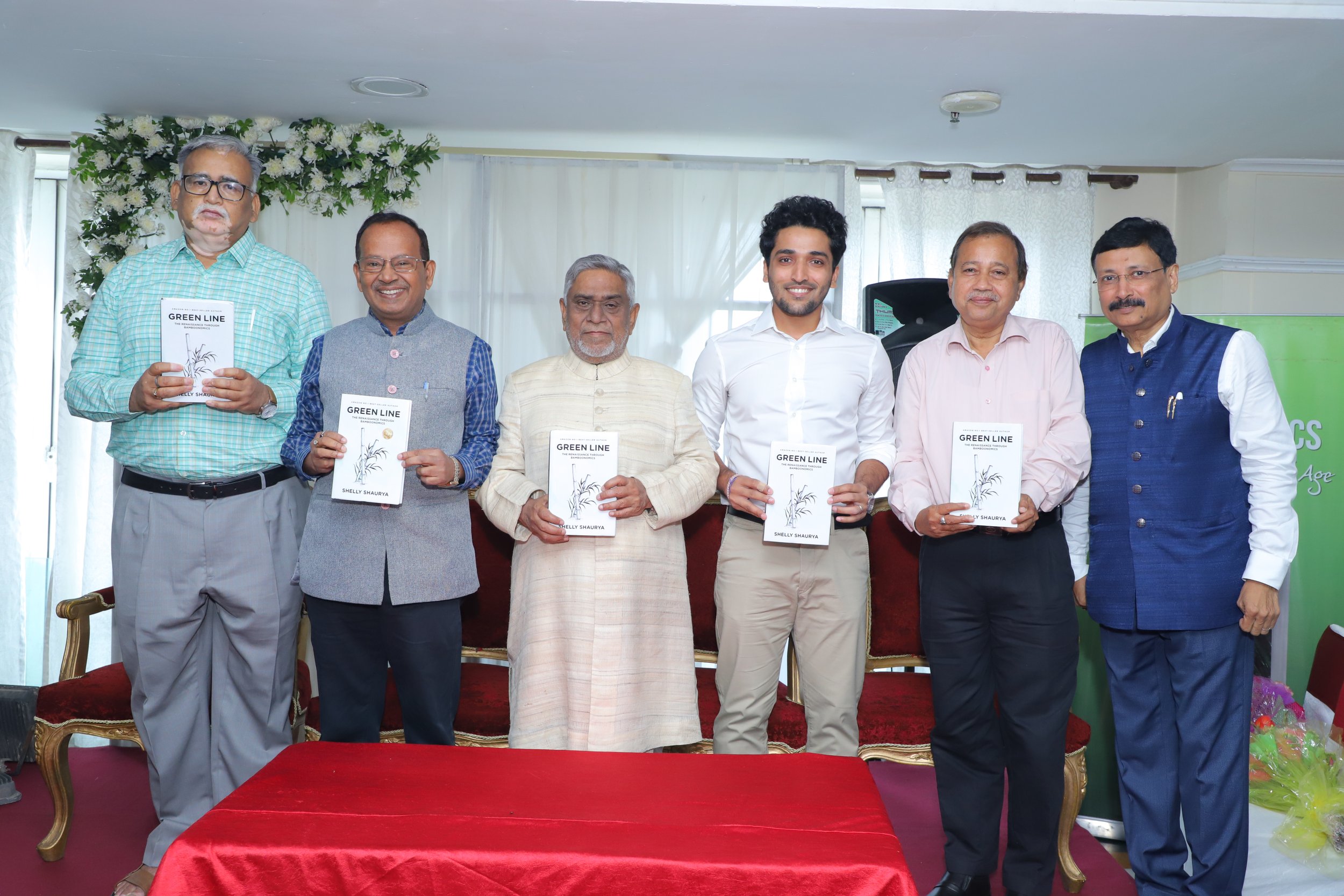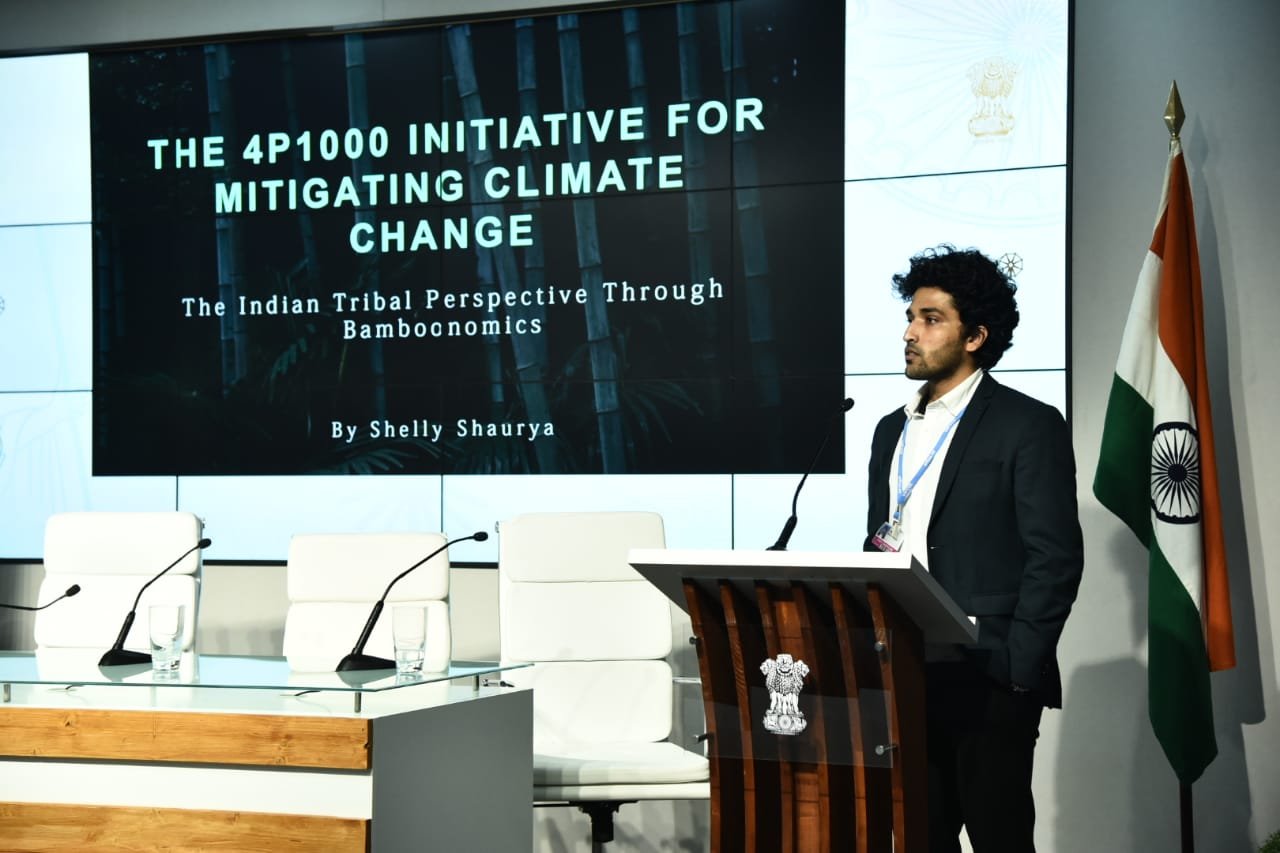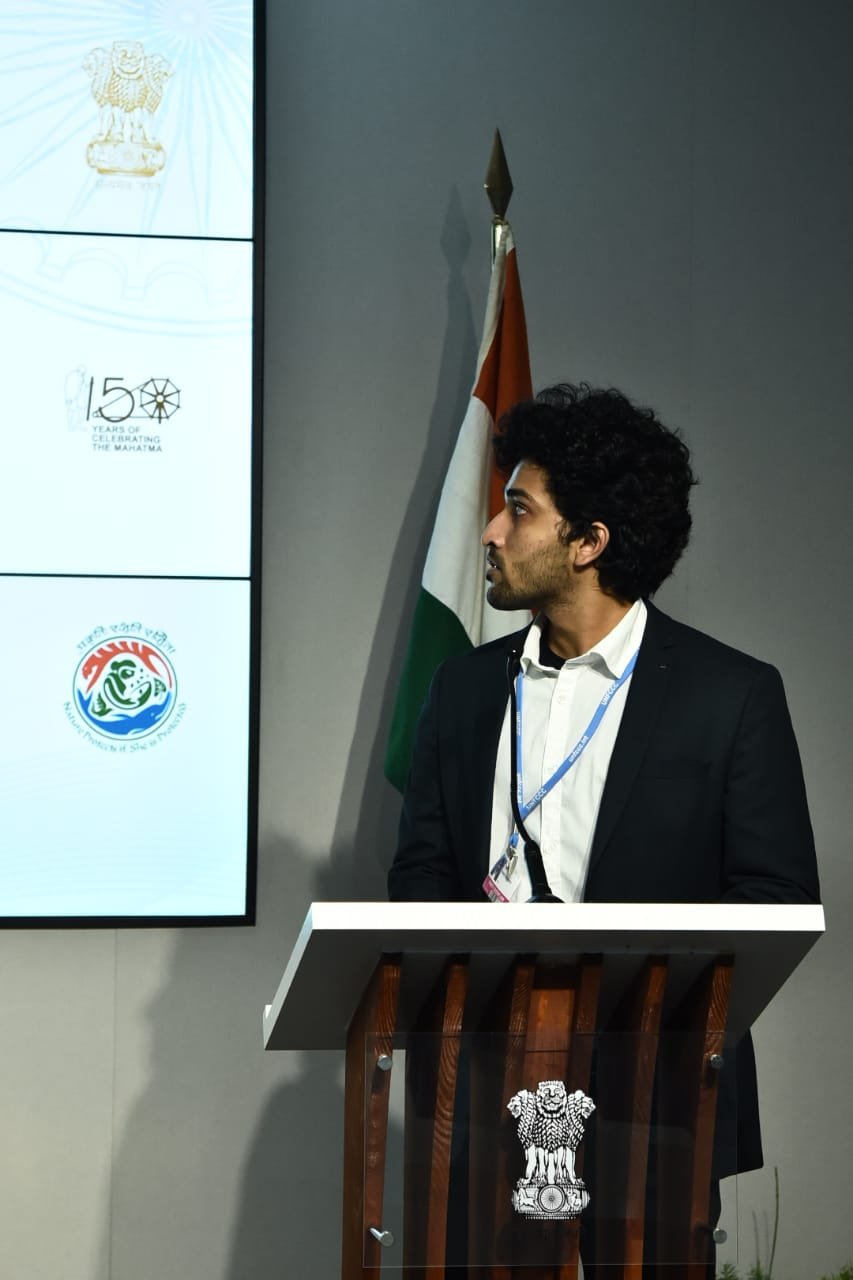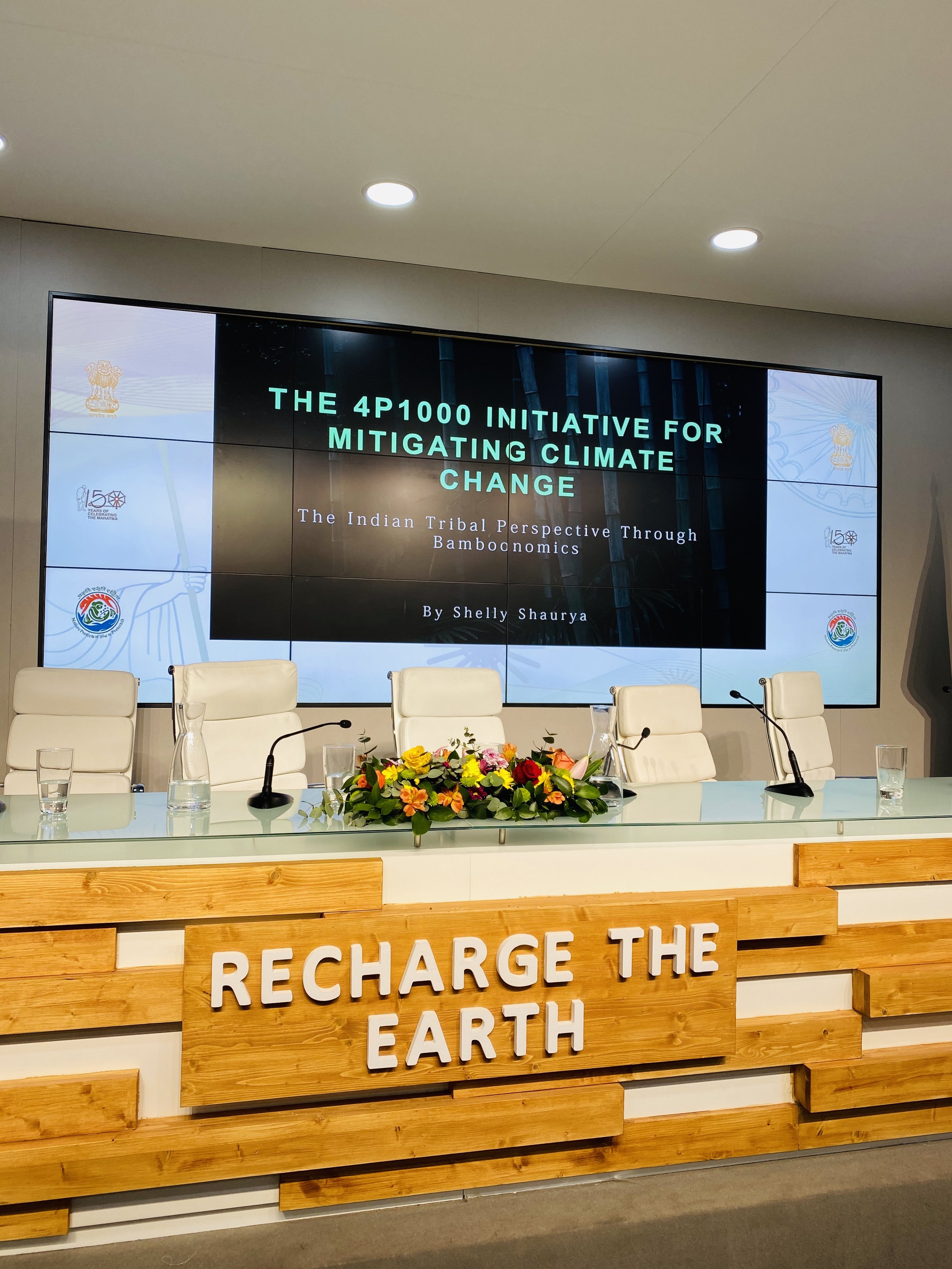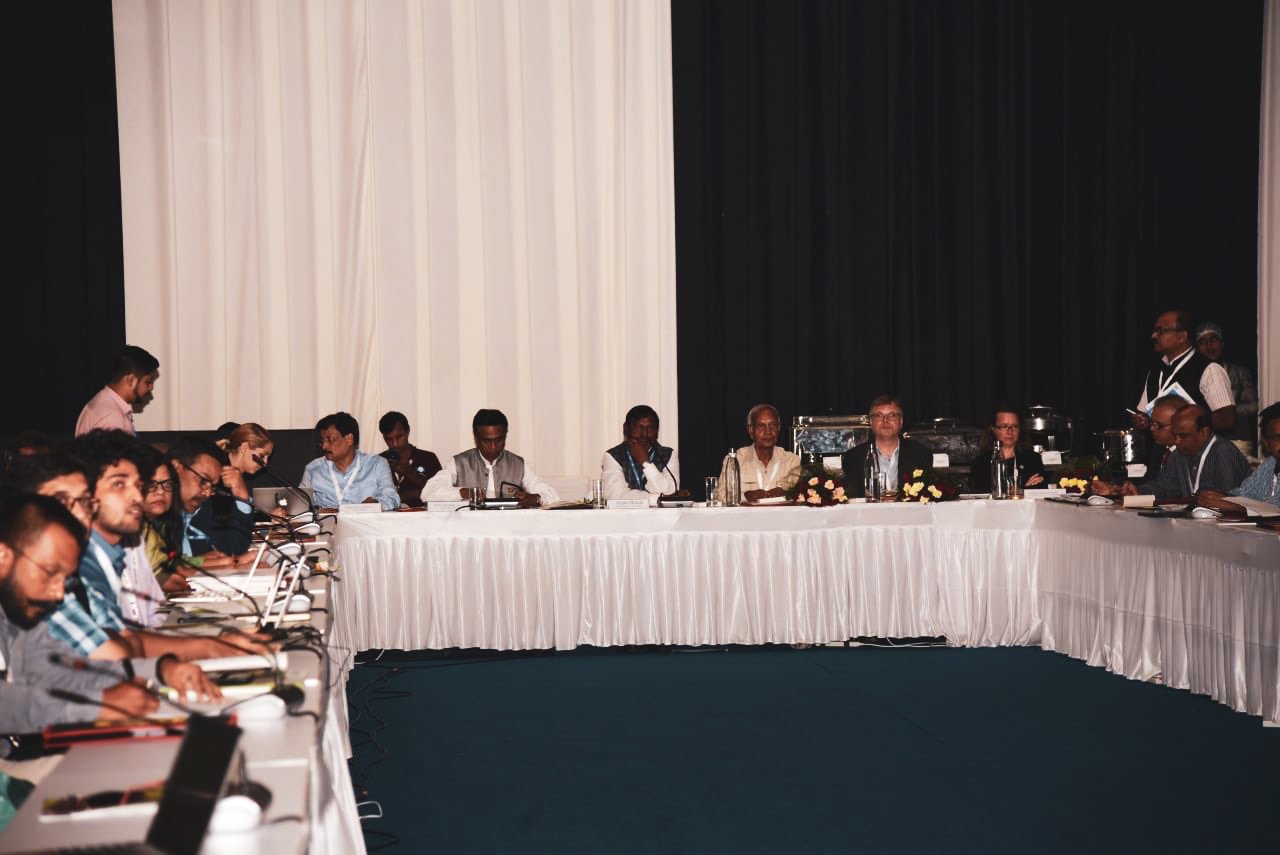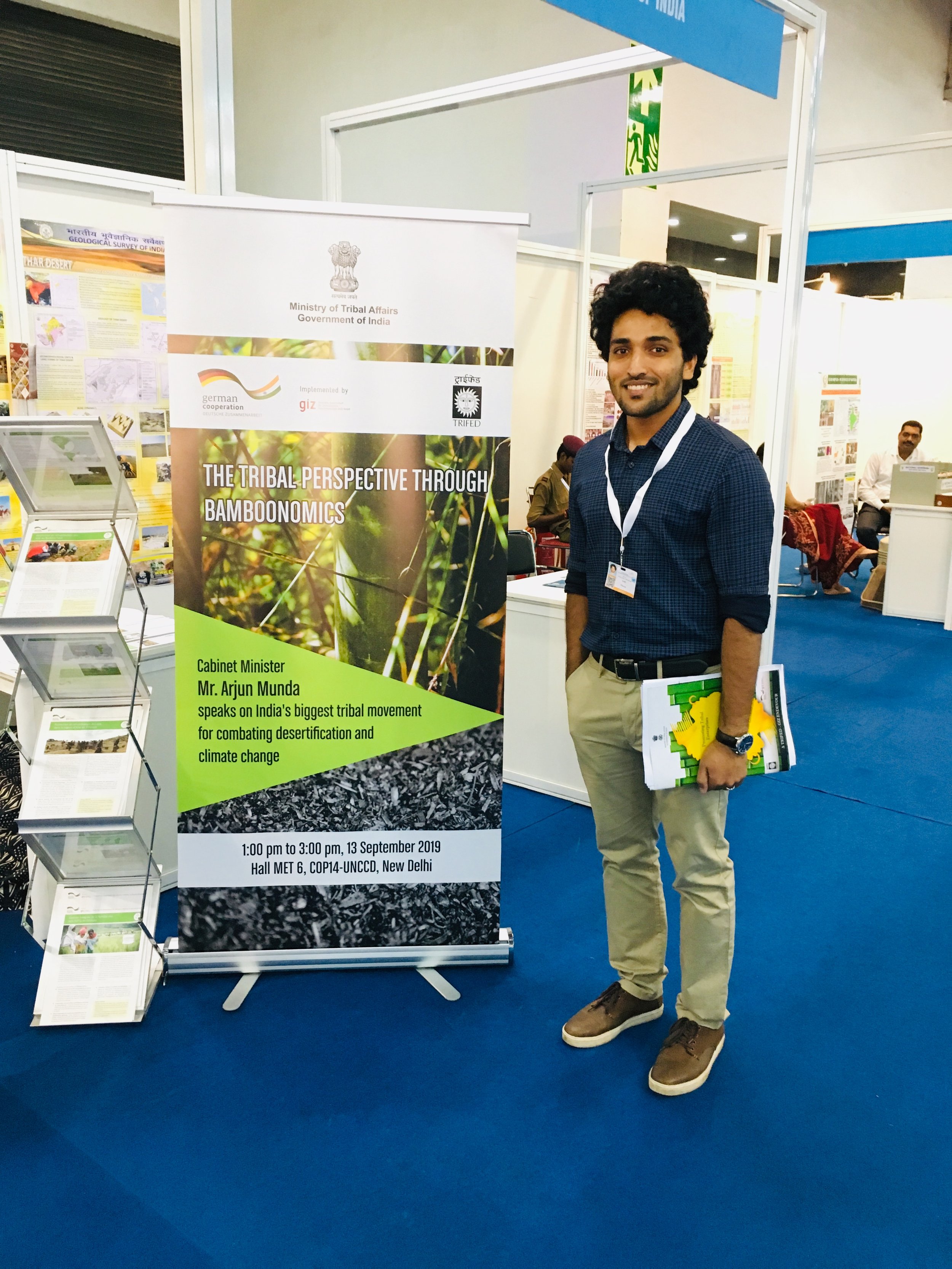
Center of Policy Research and Governance (CPRG)
Our President, Shelly Shaurya, was invited by the Center of Policy Research and Governance (CPRG) to deliver an enlightening talk on the Indian bamboo industry. The event, hosted by CPRG, an independent think tank promoting responsive policy-making, provided a platform for President Shaurya to share insights on bamboo policies, discuss future strategies, and draw from his experiences with the National Productivity Council and TRIFED.
Shelly Shaurya’s talk delved into the intricacies of bamboo policies in India, emphasizing the need for further development. He outlined the next steps to propel the industry forward, considering sustainability, economic viability, and social impact. His aim was to inspire informed decision-making and foster an environment conducive to growth.
Drawing from his experiences, he highlighted the challenges and opportunities in the bamboo sector. He emphasized his book, “Bamboonomics: The Tall Grass Comes of Age,” as a valuable resource for understanding the industry and identifying policy gaps. The book offered insights to suggest innovative policies that address challenges and unlock the potential of the Indian bamboo industry.
Center of Policy Research and Governance is a Delhi-based independent think tank promoting responsive and participatory policy-making through cutting-edge research and analysis across policy domains.

Book Event at CSOI
In a distinguished gathering of literary enthusiasts, authors Shelly Shaurya and Sanjay Kumar Srivastava took centre stage. The occasion was marked by insightful discussions on their respective works, with Mr. Shelly Shaurya presenting “Green Line” and “The Silk Saga,” while Mr. Sanjay Kumar Srivastava delved into his co-authored book “The Silk Saga” and his upcoming non-fiction release “The Shifting Cultivation.”
Shelly Shaurya, an accomplished author, enraptured the audience with his compelling narratives and profound insights. Through his books “Green Line” and “Silk Saga,” he explored thought-provoking themes, delving into the complexities of framing public policies and the intricate dynamics of the bamboo and silk industry in India.
Following Shaurya’s engaging session, Sanjay Kumar Srivastava took the stage, discussing the collaborative effort behind “The Silk Saga.” He offered a glimpse into the rich history of the Silk Route and the trade through it. Additionally, he unveiled his forthcoming non-fiction work, “The Shifting Cultivation,” enticing the audience with a preview of the book.
The event garnered attention from the media, which recognized its significance. Newspapers and online platforms highlighted the profound impact of the authors’ nonfiction works, emphasizing the intellectual discourse that unfolded throughout the event.
Distinguished guests, including bureaucrats, industry professionals, and friends of the authors, were in attendance. The gathering contributed to the event’s grandeur, fostering stimulating conversations and enriching exchanges on the power of literature to inspire change, shape perspectives, and evoke imagination.
In summary, the book event featuring Shelly Shaurya and Sanjay Kumar Srivastava concluded with a palpable sense of fulfilment and inspiration. Attendees departed with a renewed appreciation for the potential bamboo and silk industry in India.
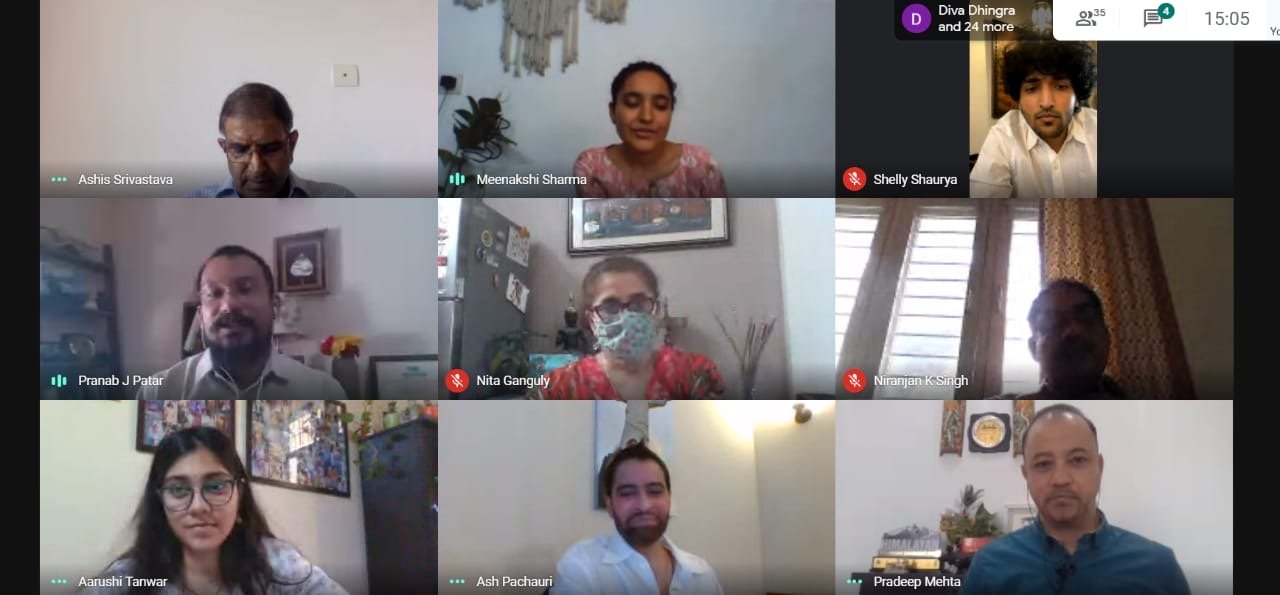
Web-Dialogue on Environment
Web-Dialogue on Environment
By
Global Foundation and CHINAR
Youth’s Perspective on India’s Environment
This was the 5th part of the web dialogue series on Environment & Sustainability Issues organized by The Global Foundation and CHINAR (Central Himalayan Institute for Nature and Applied Research).
Mr. Shelly Shaurya was invited to be a part of the panel and share his views on India’s Environment.
He spoke about how businesses can truly help save the climate. He emphasized how we need to create more business models that are pro-environment and create job opportunities for rural and tribal people. Only by involving the masses can you mitigate climate change. We can involve them by providing them with jobs and a substantial income boost through these businesses, and it’s up to us to create models that are not just environment–friendly but also improve the environment.
Citing his model ‘Bamboonomics’ as one such example, he talked about other models that can be developed, such as businesses in Ladakh and other Himalayan regions involving the shrub sea buckthorn. He spoke about the capabilities of sea buckthorn and how it can transform the economic conditions of the people of Ladakh.
Other panel members:
Dr. Ash Pachauri is an acclaimed management professional and development practitioner who has worked with MNCs, INGOs, and Multilateral Organizations, including McKinsey & Company, The Bill & Melinda Gates Foundation, UNDP, and CDC.
Ms. Aarushi Tanwar is an environmentalist, climate activist, and avid follower of sustainable living. An environmental blogger, Aarushi has a diverse career experience, having worked on issues such as waste management, air quality, environmental education, and solar energy with a different set of audiences, including – youth, school children & teachers, and residential communities, respectively.
Ms. Meenakshi Sharma is a Socio-Environmental Entrepreneur. She founded Use Me Works in 2011 with the noble belief that ‘Nothing should go to waste’. Use Me Works is an upcycling unit run by a group of enthusiastic and hardworking women to help people choose ecological options. The unit upcycles more than 200 kg of waste every month by turning it into utilities, accessories, decor, and installations.
Organizers/moderators:
Dr. Pradeep is an expert on Forestry issues. He has worked on a range of environmental issues as part of his professional stints with INGOs and Bilateral agencies, including Appropriate Technology Asia, Earthwatch, Clean Air Asia, and GIZ, to name a few. He has worked extensively in the Indian Himalaya Region over the years, undertaking collaborative research on biodiversity and ecosystem services and development projects at the community level.
Dr. Pranab Patar is an environment and sustainability professional with two decades of experience in the non-profit sector. He has worked with leading national and international organizations, including Earthwatch, TERI, GIZ, and WTI. He currently heads a Delhi-based Indo-American initiative, the Global Foundation for Advancement of Environment and Human Wellness.
You can visit the facebook page of CHINAR to see the recorded version of the talk.
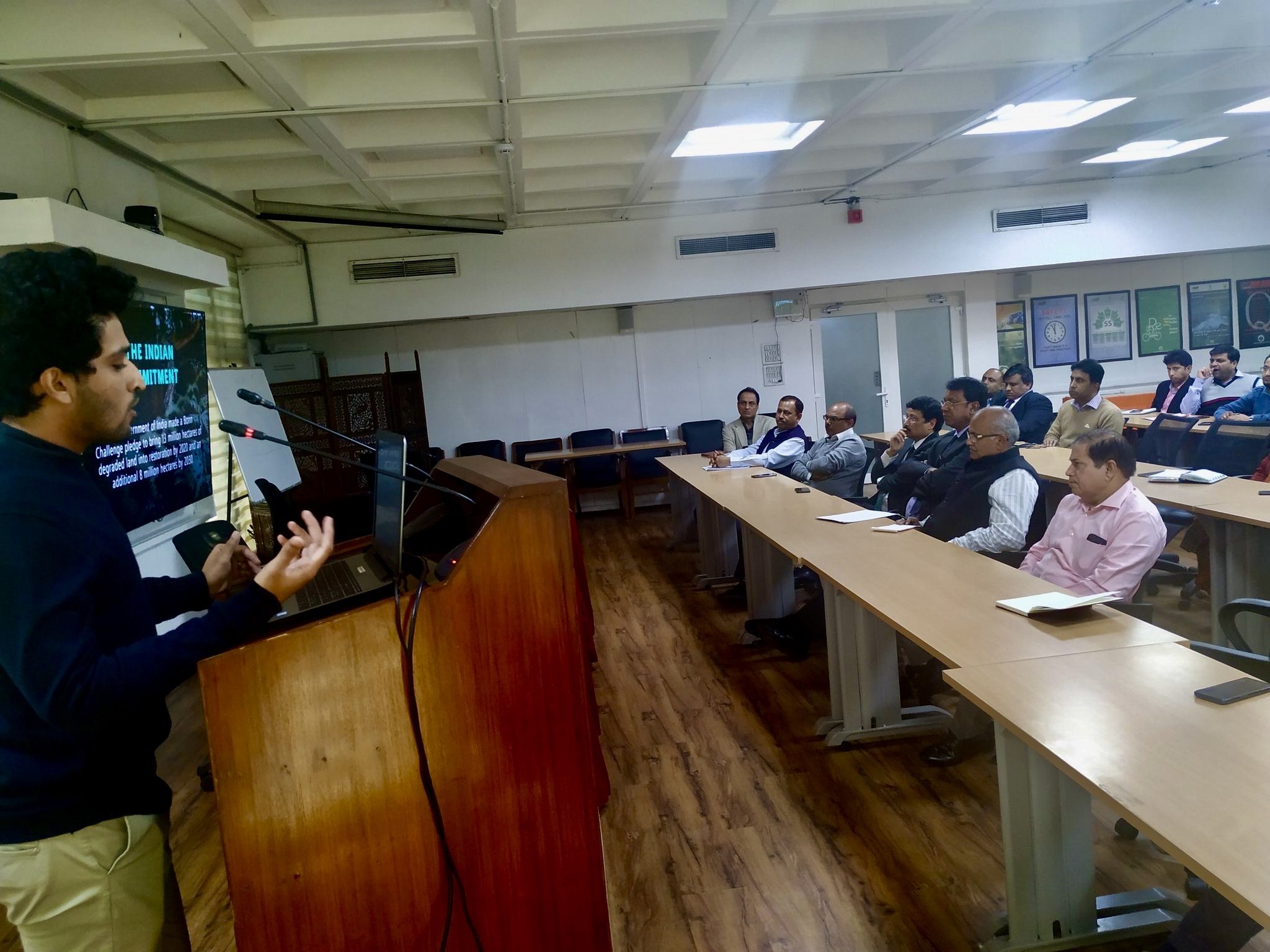
National Productivity Council, Ministry of Commerce and Industry
Our work:
Our President Mr. Shelly Shaurya made a presentation on “Bamboonomics for Productivity Enhancement of India” at the NCP headquarters in New Delhi before an august gathering of experts, officials of NPC and Director General of NPC, Mr. Arun Kumar Jha. It was a part of the productivity week conducted by National Productivity Council (NCP) wherein it invited experts from various fields to have a presentation followed by open discussion on how productivity can be enhanced in various sectors of the country.
Mr. Shelly Shaurya gave a talk on how bamboonomics can be utilised to enhance the soil fertility in India thereby leading to a significant increase in agricultural productivity.
Background material:
World over the average carbon content in the soil is around 4% while in India it is less than 1% in the plains and less than 2% in the hills. Because of this low carbon content, the productivity of the Indian soil is low compared to the soil with high carbon content.
Now to increase the carbon content wood charcoal known as ‘bio-char’ is needed which is not available in India in the desired quantity nor it is possible to convert the trees into charcoal as that will lead to a large scale denudation and environmental problems. The answer to this problem is bamboo charcoal, having been researched by SS Foundation. It is well known now that if you cut bamboo it leads to carbon sequestration, the rhizomes remain in the soil, binding it, and the new bamboo shoots grow from the rhizomes again in a couple of years leading to further carbon sequestration.
This is where the Bamboonomics pitches in with its bamboo harvesting theory (wherein to grow more bamboo you cut bamboo) and talks about its derivatives namely the bamboo charcoal and activated bamboo charcoal as proven effective tools in climate change. They can hold carbon in the soil for thousands of years and increase land productivity substantially and permanently.
A good carbon content enhances soil fertility and reduces the demand for fertilizers. While the charcoal remains in the soil for umpteen number of years and keep improving the soil fertility, it is extremely cheaper at the same time as compared to fertilizers that are applied to each and every crop every year. The charcoal infusion in the soil is only a one-time application.
The potential of charcoal in minimizing the application of urea is its greatest asset and utility and that would reduce the cost of agriculture production drastically.
All these qualities of bamboo, discovered and unearthed by bamboonomics, give it an edge over others. The bamboo forests and plantations and the Indian tribal community are going to play a big role in achieving the ‘Bonn Challenge Targets’ in the Indian context by the way of “4P1000 Initiative”.
In fact, Bamboo Charcoal is the best bet for the success of the “4P 1000 Initiative”.
Bamboo is one of the best sources to add carbon back to the soil thus not only improving the soil health but also sequestering carbon as charcoal that is made through the pyrolysis process. The bamboo charcoal so long not burnt, keeps its carbon content intact and thus extremely useful in climate change mitigation. The production and application of biochar (mainly Bamboo char or bamboo charcoal) into soils hence needs to be encouraged in India. There could be other types of bio-char other than the wood char. Waste resources like agriculture residue, garden waste, and waste from bamboo plantation and bamboo enterprises can be recycled and reused as biochar. The unique ability of bamboo to grow faster as compared to other tree species provides a good source for bio -char.
The bamboo can be harvested and value addition is done through processing enterprises. The wastage from such value addition processes can be used for converting it into a valued product i.e. bamboo char. The bamboo char thus can be added to the soil while the harvested bamboo culms grow fast, sequestering carbon.
Therefore, bamboonomics can play a crucial role in enhancing the soil quality in India leading to an increase in agriculture productivity.

UNFCCC COP 25, Madrid, Spain
Our work:
We made a presentation on the 4P1000 Initiative to mitigate climate change: The Indian Tribal perspective Through Bamboonomics. This is something that we have been working on with TRIFED. It was an honor to give a talk on this at the United Nations Framework Convention on Climate Change (UNFCCC) COP 25 in Madrid, Spain.
Background material:
There is a new global role for the Indian tribals in achieving the national and global Sustainable Development Goals (SDGs). They have a vital role to play in combating desertification and mitigating climate change. The Ministry of Tribal Affairs, Government of India’s Manufacturing and Marketing arm, called TRIFED (Tribal Cooperative marketing Federation of India Ltd.) together with GIZ has already taken several major steps in this direction for launching Bamboo based tribal enterprises. Firstly, they have hired Mr. Shelly
Shaurya, author of the Amazon’s No.1 best-Selling book titled “ Bamboonomics: The Tall Grass Comes of Age”, who had given them a report on “Bamboonomics: Aspirations in a Bamboo Regime” for making a “Bamboonomics Roll Out Plan” for TRIFED. Then after the plan was ready and approved, it was launched by TRIFED in their National Workshop titled “Bamboonomics: The Roll Out Plan for Tribal Prosperity”. There is a new global role for the Indian tribals in achieving the national and global Sustainable Development Goals (SDGs). They have a vital role to play in combating desertification and mitigating climate change. The Ministry of Tribal Affairs, Government of India’s Manufacturing and Marketing arm, called TRIFED (Tribal Cooperative marketing Federation of India Ltd.) together with GIZ has already taken several major steps in this direction for launching Bamboo based tribal enterprises. Firstly, they have hired Mr. Shelly Shaurya, author of the Amazon’s No.1 best-Selling book titled “Bamboonomics: The Tall Grass Comes of Age”, who had given them a report on “Bamboonomics: Aspirations in a Bamboo Regime” for making a “Bamboonomics Roll Out Plan” for TRIFED. Then after the plan was ready and approved, it was launched by TRIFED in their National Workshop titled “Bamboonomics: The Roll Out Plan for Tribal Prosperity” After that TRIFED in collaboration with the GIZ (German Technical Cooperation) participated in UNCCD’s COP-14 and organized a side event “The 4P1000 Initiative: The Tribal Perspective through Bamboonomics” in New Delhi. There they announced that the tribals of India would form the largest movement of tribals for combating desertification (based on the principles of the 4P 1000 Initiative) and mitigating the climate change based on Bamboonomics.
Bamboonomics & the E 3 Solution for Climate Change Mitigation
The theme for the “The 4P1000 Initiative for Mitigating Climate Change: A
Tribal Perspective through Bamboonomics is simple but provides one of the best eco-solutions for mitigating Climate Change. I term it as E 3- Solution for Climate Change Mitigation, for it is ecological (in nature), economical (in implementation) economic (in
improving its practitioners). Bamboonomics is a novel concept that represents an agrarian, predominantly tribal economy and livelihoods based on bamboo and other natural resources. It calls for an innovative and eco- friendly natural resource base development by value addition to the products that can combat desertification and mitigate climate change without sacrificing the
entrepreneurial income of the poor in the name of green eco-development. It also points out serious shortcomings in the existing bamboo policies, provides a framework for changes with a way forward.
India produces 3.23 million tons of bamboo annually covering 8.96 million hectares forest areas and 10.5 million non-forest areas. According to the Forest Survey of India (FSI), in India bamboo grows in 8.96 million hectares of forest area, which constitutes about 12.8% of the total forest area of the country. A substantial number of tribal live in these areas and they cannot be ignored in the climate
change mitigation efforts. The Bamboo can grow again from its same rhizomes, it grows very fast and sequesters more carbon as compared that by trees. This quality makes it a very vital tool in climate change mitigation. It could help India to achieve its tough targets under the “Bonn Challenge“ of bringing 13 mha of degraded land into restoration by 2020 and an additional 8 mha by 2030 at a lesser expenditure as compared to that of tree plantations. India is also felling short of the Climate Change Mitigation targets by 1.1 billion tons of carbon stock. This is where the Bamboonomics pitches in with its bamboo plantations and its derivatives the Bamboo- charcoal and Activated Bamboo Charcoal as proven effective tools in Climate Change Initiatives. They can hold the carbon for thousands of years and increase the land productivity substantially on the application as the soil carbon content is improved. It involves the tribal stakeholders for rehabilitating the degraded land without compromising their livelihood income through bamboonomics. Thus, while doing crucial environmental services, the tribals will earn more through Bamboonomics livelihood systems.
The Indian Perspective towards Climate Change Mitigation is basically based on the Forestry point of view has always been by the way of tree plantations leading to carbon Sequestration and thus mitigating climate Change. One of the off shoots of these tree
plantation activities is arresting the desertification. There are gaps in the Climate Change Program based on the tree plantations and to suggest not only policy changes but a quicker and surer way out based on “4P 1000 Initiative” to support the efforts being made in this arena and at the same time enhancing the income of the poor to almost 4 times of their present livelihoods of the rural and tribal areas. Bamboonomics envisages action on part of the rural and tribal communities through SHGs and proposes to assess the growing stock utilization of bamboo that how much of it could be converted into Bamboo Charcoal (BC) and Activated Bamboo Charcoal (ABC). Once we market it in a sustainable way without compromising the existing livelihood options for the rural and tribal communities and are able to keep the sequestrated carbon stock either in the soil in the form of charcoal or use it in the form of un-burnt charcoal and activated charcoal in various industrial and FMCG industries, we are helping the cause of climate change.
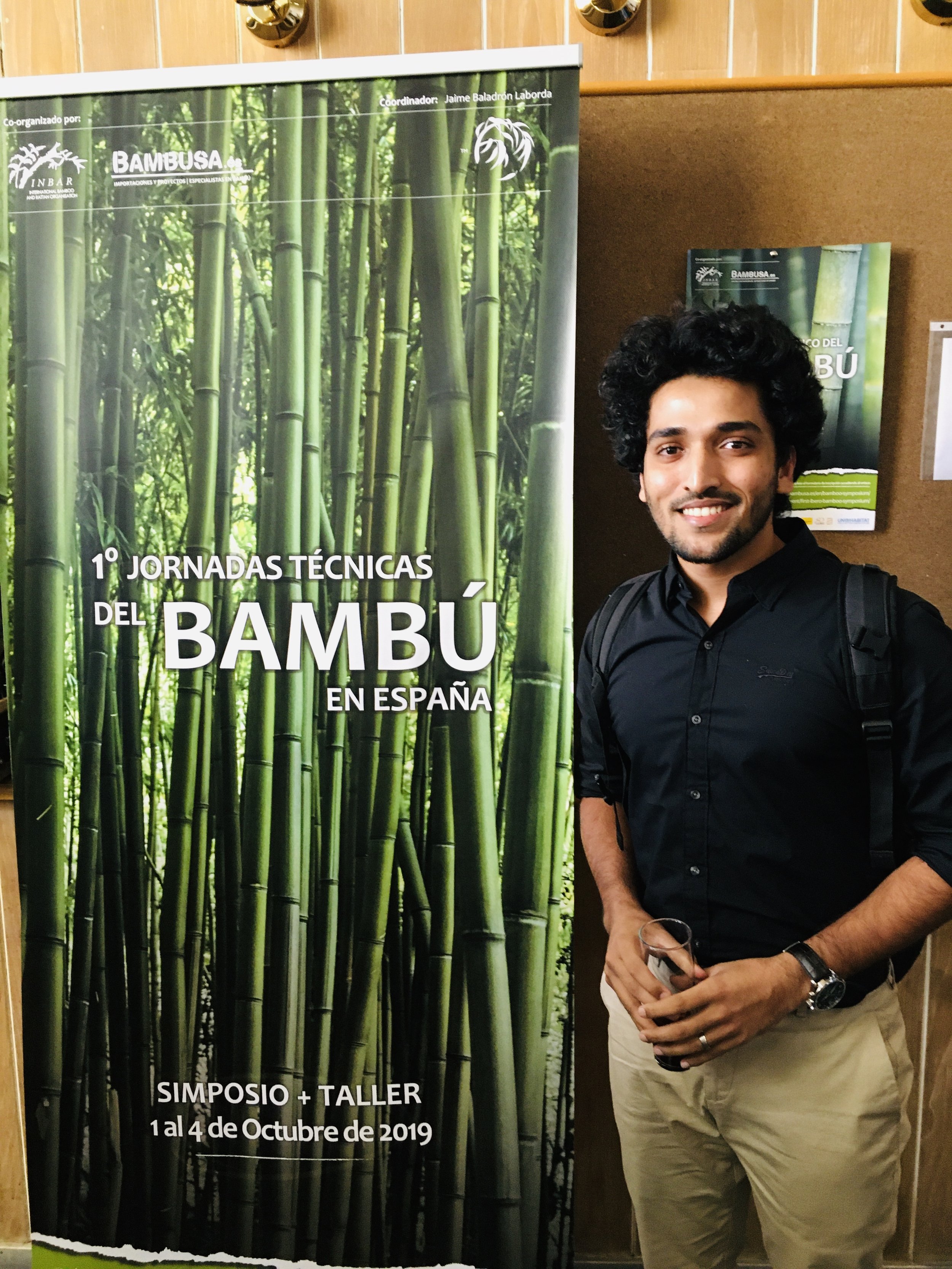
1st Ibero-Bamboo Symposium, Madrid, Spain
Our President Mr. Shelly Shaurya was invited by INBAR to attend the First Ibero-Bamboo International Symposium held in Madrid, Spain in October 2019. He attended the same and made important interventions regarding the potential economic and ecological value of bamboo that can be harnessed by European Nations. He also talked of his theory of Bamboonomics that was listened to keenly by various experts and they admired his research that is going to usher in a new Bamboo Regime of Economic and Ecological Growth in the identified States in India.
The agenda for the symposium was to bring in experts in the field of bamboo from around the world and discuss and devise a plan to help Spain be a gateway to the bamboo industry for Europe.

UNCCD COP 14, Noida, India
Our work
We are providing expert solutions to TRIFED on the project “Bamboonomics”, which launched by the Govt. of India during the United Nations Convention to Combat Desertification (UNCCD) COP 14 in Noida, India.
We designed the whole project on how the tribal community will help India achieve its “Bonn Targets” without ignoring their entrepreneurial income in the green eco-development.
TRIFED’s Global Responsibility: COP14 of UNCCD: Cooperation with GIZ
There is a new global role for the Indian tribals and the TRIFED and for that the task of organizing a Side Event titled “The 4P1000 Initiative: The Tribal Perspective through Bamboonomics” during the global meet of the countries in New Delhi in September 2019 i.e. COP-14 of UNCCD has been entrusted to TRIFED. It is being supported by GIZ in this endeavor.
We all know that the world over average carbon content in the soil is around 4% while in India it is less than 1% in the plains and less than 2% in the hills. Because of this low carbon content, the productivity of the Indian soil is low compared to the soils with high carbon content.
For this, the wood charcoal known as bio-char is needed which is not available in India in the desired quantity nor it is possible to covert the trees into charcoal as that will lead to large scale denudation and environmental problems. The answer to this problem is bamboo plantations and making bamboo charcoal. It is well known that if you cut bamboo, it leads to more carbon sequestration and the rhizomes remain in the soil, binding it, and the bamboo grows from the rhizomes again and does more carbon sequestration.
Now as per “National Bamboo Mission”, Ministry of Agriculture, Government of India, out of 136 species of bamboo only around 10 are economically viable under the present technological scenario. This poor quality bamboo and the decaying bamboo lying idle in the fringes of forests and even in the forests can be converted to bamboo charcoal. The bamboo charcoal has a great market and it is on sale at Amazon.in in a big way. The bamboo – charcoal would not only help in soil resilience but its sale would generate extra income for the community. So, this bamboo char and it’s commercial value could come from the so-called-unimportant commercially unviable bamboos growing in India and the bamboo char from these would make them a viable species.
Moreover, as we know the cutting of bamboo helps in carbon sequestration as the rhizomes remain in the soil and from them new shoots of bamboo come up and in 5 to 7 years the full stock is resurrected. There are species of bamboo that can grow in degraded soils and they could be planted. The short rotation period of bamboo is very handy in this endeavor. Given an average lifespan of 20-25 years and fast-growing clumps, bamboo can sequester a very large amount of carbon (depending on the cultivation techniques). Then Indian bamboo is invasive in nature. So, bamboo covers the area once it is planted. That saves time, energy, and money as compared to tree plantations. Then bamboo plantations are almost maintenance-free. All these give it an edge over others.
Bamboonomics: The 4P1000 Initiative
The global 4P1000 Initiative, established at COP21 of UNFCCC, aims at increasing soil carbon stocks by 0.4 percent annually through a transition towards sustainable agricultural production and development and promoting farming techniques that combat soil erosion and improve soil health. This initiative is interwoven into the “The Bonn Challenge” under which Germany, India, and many other countries decided to rehabilitate 350 million ha. of degraded lands by 2030 leading to substantial carbon sequestration.
India is a signatory of “The Bonn Challenge” and one of the important actors in the “4P1000 Initiative” for Climate Change Mitigation.
The international “4 per 1000 Initiative”, launched by France on 1 December 2015 at the COP 21 of UNFCCC (United Nation Convention for Climate Change)”, consists of federating all voluntary stakeholders of the public and private sectors (national governments, local and regional governments, companies, trade organizations, NGOs, research facilities, etc.) under the framework of the “Lima- Paris Action Plan (LPAP)”.
The aim of the initiative is to demonstrate that forests and agriculture, and in particular agricultural soils can play a crucial role where food security and climate change are concerned.
Supported by solid scientific documentation, this initiative invites all partners to state or implement some best practices (e.g. agro-ecology, agroforestry, conservation agriculture, landscape management, etc.) to achieve this goal.
This target was endorsed by the UN Climate Summit in 2014 and extended to 350 million hectares under restoration by 2030. The Bonn Challenge is not a new global commitment, but rather a practical way of realizing many existing international commitments, including the CBD (Convention on Biological Diversity) Aichi Target 15, the UNFCCC REDD+ goal, and the Rio+20 land degradation neutral goals.
Experts say that achieving the 350-million-hectare goal could generate US $170 billion per year in net benefits from watershed protection, improved crop yields, and forest products, and could sequester up to 1.7 gigatonnes of CO2 equivalent annually. Prior to COP 21, 13 countries and a regional alliance had pledged almost 60 million hectares to the Bonn Challenge.
“Paris COP 21 and Global Landscapes Forum 2015 are not just about political commitments. They are about actions and implementation,” says Franzjosef Schafhausen, Director general at Climate Policy, Federal Ministry for Environment, Nature Conservation, Building, and Nuclear Safety, Government of Germany. “Bringing back degraded and deforested lands can help stabilize the climate while sustainably supporting global and local economies.”
According to the “IUCN- MOEF&CC Report”, known as “The Bonn Challenge and India: Progress on Restoration Efforts Across States and Landscapes Report”, India has brought an area of 9.8 million hectares under restoration since 2011, meaning that the work to restore these landscapes is already underway. Of the 9.8 million hectares, 94.4% was contributed by government agencies, while the surveyed NGOs and private companies contributed 3.6% and 2% respectively.
At the UN Framework Convention on Climate Change (UNFCCC) Conference of Parties (COP) 2015 in Paris, the Government of India made a “Bonn Challenge Pledge” to bring 13 million hectares of degraded land into restoration by 2020 and an additional 8 million hectares by 2030.
This task is overambitious as has been explained a little later.
Even the Secretary, Ministry of Environment, Forest and Climate Change during the meeting of the Parliamentary Committee held on 9th April 2018 informed the Committee that one of our global commitments, for which forest is very important, is our commitment to add an additional 2.5 to 3 billion tonnes of CO2 equivalent by 2030. Presently, the carbon stock in the country is about 7 billion tonnes which is equivalent to 25 plus billion tonnes of CO2 equivalent. We are growing at about 35 million tonnes every year. If this growth continues until 2030, we can add about 1.9 billion tonnes of CO2. However, the Country will still be short of our global commitment by about 1.1 billion tonnes of carbon stock which is a cause of worry. Therefore, the Ministry is designing schemes to achieve this target, which are being implemented by the State Governments, and most of the funding is also done by the State Governments. The government of India does very little direct funding in increasing forest cover.
In broad terms, India is committed to sequestering 2.5 to 3 billion tonnes of carbon dioxide equivalent in the forests by the year 2030.
On being enquired by the Committee as to how this will be achieved, the representative of the Ministry submitted that they have put in the Draft National Forest Policy to have a two-pronged approach for that. They informed that in the natural forests, the carbon dioxide is more in the soil than the ground flora and hence, New Forest Policy stresses the need of enhancing the quality of the forest. The first strategy of the Government in the policy is that we will use the natural forest as a sink to improve the quality and that will be done by a catchment area treatment plan. By treating the catchments, we can provide water security to the country and also accelerate the carbon sequestration in the natural forests.
The second strategy is that our total forest and tree cover is 24.39 percent whereas our National Policy envisages 33 percent. Hence, we will be focusing more on agro- forestry systems. We will have the agricultural crop, which will commensurate with those tree crops so that we grow the trees outside the forests because the trees are the carbon-neutral resource. If we are able to grow more trees outside the forest and enhance the tree cover, it will not only sequester carbon dioxide but the nation will also have more renewable resources like wood for our use. In this regard, the country’s slogan is ‘Grow more wood, use more wood’ so that we have more wood products and then we can not only save on our foreign exchange but also enrich our own forests.
It was further submitted that India has the potential of achieving an additional 3 billion tonnes of CO2 equivalent sequestration by 2030 with conservation and afforestation approach on forests and non-forest land. Around INR 60000 crore per annum is needed until 2030 for forest development, livelihood activities, implementing the MSP scheme for agro-forestry, and providing LPG to the forest dependent communities. The innovative financial mechanism to obtain forest-based carbon finance through Carbon Neutrality Policy will boost the efforts towards achieving the target. It is not possible to achieve this target without the involvement of people, the private sector, and other Government Departments. In the recent past, some states like Uttar Pradesh, Maharashtra, and Andhra Pradesh, etc. have shown commitment towards having a special drive for afforestation. The same kind of commitment is needed from the Central Government and other State Governments on a regular basis.
The Committee agreed with the views expressed by The Energy and Resources Institute (TERI) as well as the Ministry that India has the potential of achieving additional 3 billion tonnes of CO2 equivalent sequestration by 2030 with conservation and afforestation approach on forests, degraded forests and non-forest land. However, the Committee felt that the Country needs to have a holistic approach and at the same time concerted efforts are required from one and all and peoples’ involvement, particularly the tribals & traditional forest dwellers, for achieving this important commitment of United Nations Framework Convention on Climate Change (UNFCC) for addressing the issues of climate change adaptation and mitigation.
It seems that “The Bonn Challenge” of treating 21 mha. of degraded land has more chances of success in such countries where the development might be poor but the population is under tolerable limits and really concerned about the environment. Then the role of governance becomes very vital. A responsive bureaucracy is very much needed that should not think of themselves as a solution for all the problems but merely as one of the tools but not the only tool to resolve the issues.
Bonn Challenge is going to face such structural issues in India that might seriously hamper the target achievement in the true sense of the term. Currently, all the good vibes that UNCCD is receiving from India, it is afraid, may not turn out to be successful in the long run without TICD, Bamboo, and Bamboo charcoal.
Thus, India poses a special challenge to Bonn Challenge 2020 & 2030 aspirations pertaining to the socio-economic and management issues. And unless address carefully the ambitious targets, set for itself by IUNC – GOI combine would be extremely difficult to achieve. In India, land degradation and food security has always been the pressing problems in India and what has not been achieved in the past 70 years will be difficult to achieve by 2030 if new thinking and new solutions are not offered and adhered to. There is a need for a multi-prong strategy and a direct approach to tackle the problem of soil degradation.
There is a daunting task before the Government and it would not be easy to achieve without the active involvement of TRIFED under the Ministry of Tribal Affairs, Government of India, and without massive participation of the tribal community. It is they who live in forests, dependent on it, and are the direct stakeholders in millions in sheer numbers. TRIFED is mobilizing them to participate in 4P1000 Initiative in order to achieve the Bonn Challenge 2020 & 2030 in India. It is a fight on a war – footing as the challenge is not easy to bring forth so many million ha. of degraded lands into LDN (Land Degradation Neutrality) Status. But involving a large number of tribal with suitable incentives by the way of alternative livelihoods can make this possible.
This is in complete agreement with the observation of the Parliamentary Committee on Forests, Environment & Climate Change made on 09.04.19.
TRIFED Initiative for Combating Desertification (TICD) & GIZ- India’s Pro – Soil
The Bamboo forests and plantations and the Indian tribal community are going to play a big role in achieving the Bonn Challenge targets in the Indian context by the way of “4P1000 Initiative”.
It is expected that in total out of 105 million tribal populations in India, around 30-35 million Indian tribal population would be participating in this endeavor. Thus, it is the largest tribal movement in the world in combating the desertification through bamboo plantations and Bio – Char / Bamboo – char or bamboo charcoal is being mobilized by the TRIFED. We are naming it tentatively as the
“TRIFED Initiative for Combating Desertification (TICD) .”
GIZ – India’s Pro Soil i.e. Soil Protection and Rehabilitation in India Division has joined hands with TRIFED in this great exertion.
Advantage Bamboo & Bio-Char
The bio-char especially bamboo-char could be a great tool in this effort of achieving Bonn Challenge targets. The charcoal would not only help in soil resilience but its sale would generate extra income as stated earlier. Moreover, as stated earlier, the cutting of bamboo helps in carbon sequestration as the rhizomes remain in the soil and from them new shoots of bamboo come up and in 5 to 7 years and the full stock is resurrected. The Bamboo forests and plantations are going to play a big role in it and unfortunately, all the actors like the Ministry of Agriculture including Restructured Bamboo Mission, Agro-Forestry Division, NABARD, MOEF&CC, and the Ministry of Rural Development are blissfully unaware of it.
Why the “Bio-Char” and Bamboo Charcoal (Bamboo-char) are Excellent for Combating Desertification?
Let’s first understand what is “Bio- Char” as “Bamboo –Char” is only a specific bio – char.
Stefanie Spears explains “Bio-char” as a charcoal-like substance that’s made by burning organic material from agricultural and forestry wastes (also called biomass) in a controlled process known as pyrolysis (the thermal decomposition of biomass in an oxygen-limited environment).
Although it looks a lot like common charcoal, bio-char is produced using a specific process to reduce contamination and safely store carbon. During pyrolysis, organic materials, such as wood chips, leaf litter, or dead plants, are burned in a container with very little oxygen. As the materials burn, they release little to no contaminating fumes. During the pyrolysis process, the organic material is converted into bio-char, a stable form of carbon that can’t easily escape into the atmosphere. The energy or heat created during pyrolysis can be captured and used as a form of clean energy. Bio-char is by far more efficient at converting carbon into a stable form and is cleaner than other forms of charcoal.
In terms of physical attributes, bio-char is black, highly porous, lightweight, fine-grained, and has a large surface area. Approximately 70 percent of its composition is carbon. The remaining percentage consists of nitrogen, hydrogen, and oxygen among other elements. Bio-char’s chemical composition varies depending on the feedstocks used to make it and methods used to heat it.
The quality of feed-stocks, or materials burned, has a direct impact on the quality of the final bio-char product. Ideally, clean feedstocks with 10 to 20 percent moisture and high lignin content must be used—some excellent examples are field residues and woody biomass. Using contaminated feed-stocks, including feedstocks from railway embankments or contaminated land, we introduce toxins into the soil, drastically increase soil pH and/or inhibit plants from absorbing minerals. The most common contaminants are heavy metals—including cadmium, copper, chromium, lead, zinc, mercury, nickel, and arsenic—and polycyclic aromatic hydrocarbons.
Bio-char can be manufactured at low-cost, small-scale production using modified stoves or kilns, or through large-scale, cost-intensive production, which utilizes larger pyrolysisplants and higher amounts of feedstocks. One of the most common ways to make bio-char for on-farm use is through pyrolysis using a top-lit updraft bio-char machine.
Applications of Bamboo Charcoal in Agriculture: Enhancing Soil and Compost Properties
Soil degradation is a major concern in agriculture globally. To address this burgeoning problem, researchers suggested applying bio-char/bamboo charcoal to degraded soils in order to enhance its quality.
Some of the ways that bio-char/bamboo charcoal may help improve soil quality include:
Enhancing soil structure
Increasing water retention and aggregation
Decreasing acidity
Reducing nitrous oxide emissions
Improving porosity
Regulating nitrogen leaching
Improving electrical conductivity
Improving microbial properties
Bio-char is also found to be beneficial for composting since it reduces greenhouse gas emissions and prevents the loss of nutrients in the compost material. It also promotes microbial activity, which in turn accelerates the composting process. Plus, it helps reducethe compost’s ammonia losses, bulk density, and odor.
Thus, Bio-char/bamboo charcoal is almost a charcoal used as a soil amendment. Bio-char is a stable solid, rich in carbon, and can endure in soil for thousands of years.
Bamboo charcoal: An Environmental Solution
Bio-char/bamboo charcoal may seem like a simple material, but it can help solve a variety of global problems simultaneously. For instance, the process by which it’s manufactured may help sequester a billion tons of carbon annually and hold it in the soil for thousands of years, where it’s most beneficial.
During the production of bio-char/bamboo charcoal, clean and renewable energy is produced as a byproduct and this can be used as an alternative to burning fossil that has exacerbated global warming by adding greenhouse gases to the atmosphere.
Some of the other environmental benefits of bio-char/bamboo charcoal include decreased groundwater pollution, lower cost of water filtration, reduced amounts of waste, and higher profitability for farmers. This technology also contributes to food security by increasing crop yields and retaining water in areas prone to drought.
The Concept of Bio-Char Is Rooted in An Ancient Amazonian Practice
Although bio-char technology is considered a more recent strategy for carbon sequestration, the practice of adding charred biomass to improve soil quality is not new. This process is modeled after a 2,000-year-old practice in the Amazonian basin, where indigenous people created areas of rich, fertile soil called “terra- preta” (meaning “dark earth”).
Whether these soils were intentionally made or are simply a by-product of farming and/or cooking practices is still not known and we can make only an intelligent guess. But it was seen that the fertility of “terra preta” is significantly higher than the otherwise notoriously infamous infertile soils of the Amazon. This explains why plants grown in terra-preta soil grow faster, and are denser in nutrients than plants grown in neighboring soils. In fact, terra – preta soils continue to hold carbon still today.
How to use bamboo charcoal to Improve Soil Quality
Bamboo charcoal is applied to agricultural soils using a variety of application rates and preparation techniques. The rate of application and preparation of the bamboo charcoal will largely depend on specific soil conditions as well as on the materials used to make the bamboo charcoal. It is often recommended to mix bamboo charcoal with compost or other materials to inoculate it with nutrients and beneficial organisms.
The recommended method for applying bamboo charcoal will vary depending on how healthy or nutrient-depleted your soil is. Before you use bamboo charcoal in your own garden or farm, you should first consider the state of your soil.
